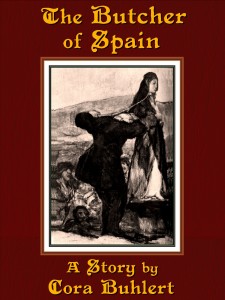 Spain during the Napoleonic Wars: Captain Jonathan Farnsworth of the Rifle Brigade only wanted to meet with some Spanish allies and spend a few stolen hours with Comandante Teresa, rebel leader and the woman he loved. But instead Jonathan stepped into a scene of pure horror, when he found the village burning and its people slaughtered.
Spain during the Napoleonic Wars: Captain Jonathan Farnsworth of the Rifle Brigade only wanted to meet with some Spanish allies and spend a few stolen hours with Comandante Teresa, rebel leader and the woman he loved. But instead Jonathan stepped into a scene of pure horror, when he found the village burning and its people slaughtered.
Teresa was not among the dead. However, she had been captured by the Napoleon’s troops and was now the prisoner of the notorious French colonel known only as El Carnicero, the butcher. And tomorrow, Teresa would be executed on the garrotte as a rebel…
Warning: There is some fairly graphic violence in this novelette, so sensitive readers should tread carefully.
Read an excerpt.
Watch the book trailer for El Carnicero.
Visit the The Butcher of Spain Pinterest board.
List price: 2.99 USD or EUR, 1.99 GBP
But it at Amazon US, Amazon UK, Amazon Germany, Amazon France, Amazon Spain, Amazon Italy, Amazon Canada, Amazon Brazil, Amazon Japan, Amazon India, Kobo, Barnes & Noble, Apple iTunes, Casa del Libro, W.H. Smith, Nook UK, DriveThruFiction, OmniLit/AllRomance e-books and XinXii.
More formats coming soon.
Some background information:
- The Butcher of Spain is 7600 words long and was originally published in Man’s Story 2 No. 9 under the title “El Carnicero”. I changed the title for the e-book edition, because the original Spanish language title was confusing potential readers.
- Even though it is set during the Regency era, The Butcher of Spain is definitely not a Regency romance. If anything, this story explores the nightmare side of the Regency
- As a teenager, I saw what I hope was a replica garrotte in the chamber of horrors of Madame Tussaud’s in London. The device both horrified and intrigued me and I immediately decided that I would put it in a story some day. Alas, it took almost twenty years for me to find the matching story.
- Other inspirations include Bernard Cornwell‘s Sharpe novels and the TV adaptions starring Sean Bean, Georgette Heyer’s The Spanish Bride and Francisco de Goya y Lucientes’ art, particularly his Desastres de la Guerra cycle. Goya coincidentally also provided the cover painting, though it is not part of the Desastres de la Guerra.
- All characters and towns are fictional. However, there were female guerrilla fighters in Spain during the Peninsular War such as Juana Galán and Agustina de Aragón.
- The character of the seamstress Dolores Azucena is loosely based on Spanish freedom fighter Mariana de Pineda Muñoz, though she was executed in 1831, i.e. almost twenty years after the events in this story.
- The various grisly happenings in this story are sadly true to history, as there were plenty of atrocities committed on all sides during the Peninsular War.
- The garrotting scene is based on an eye witness account by Richard Ford of the execution of a robber named José de Roxas, which I found in a book on the history of capital punishment. The full text of Ford’s Gatherings from Spain is here. The German historical novelist Lion Feuchtwanger used the same eye witness account in his novel Goya oder der arge Weg der Erkenntnis (1951, English title This is the Hour). My professor was very impressed when I traced the garrotting scene in Goya back to this particular eye witness account in a paper I wrote on Feuchtwanger’s historical fiction at university.
- If you have never read Lion Feuchtwanger, I heartily recommend him by the way.
- Many of the names in this story have figurative meanings. The village of Los Horcados translates as “The hanged”. The town of Alcázar des Verdugos translates literally as “Palace of torturers”. And Jacques Bourreau, El Carnicero’s real name, means “executioner”. Okay, so those are a bit blunt, but the story was originally written as a spicy pulp adventure.
- The cover image is by Francisco de Goya y Lucientes and supposedly depicts a witch being strangled by an executioner who is so terrified of her magic that he won’t look her in the eye. It’s an obscure work – all I know about it is that it is held by the Bavarian State art collection, most likely at the Neue Pinakothek in Munich. Goya extensively chronicled the horrors of both the Spanish justice system and the Peninsular wars and actually did depict at least two garrottings. Alas, those images are fairly graphic, besides the victims are men. So I chose this particular image because it makes its point without being overly graphic. Besides, the obvious pride and defiance of the woman about to be executed remind me of Teresa.
- The original cover may be seen here.
 Send to Kindle
Send to Kindle
 sending...
sending...
Pingback: New Book Trailer for El Carnicero | Pegasus Pulp
Pingback: The Princess and the Baker’s Boy – or why I write unconventional gender dynamics | Pegasus Pulp
Pingback: Our One Year Anniversary | Pegasus Pulp
Pingback: New title, new cover, new video | Pegasus Pulp
Pingback: Old Mommark and the eight hour e-book challenge | Pegasus Pulp
Pingback: How to make book trailers using free online services | Pegasus Pulp
Pingback: Our Six Year Anniversary | Pegasus Pulp
Pingback: The Big 3000 | Pegasus Pulp
Pingback: Our Seven Year Anniversary | Pegasus Pulp